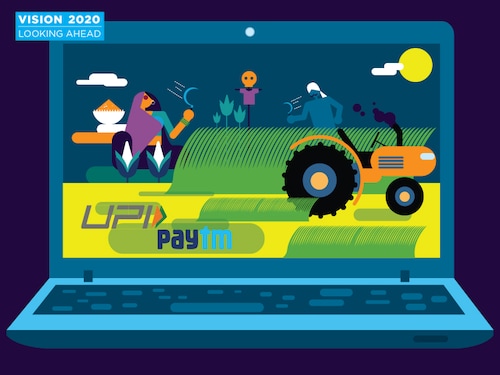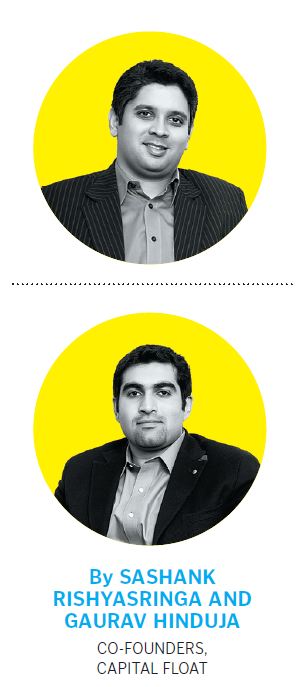'Fintech will help unlock Bharat'
A new kind of financial institution, powered by technology, will have far reaching implications for the overall economy, write the co-founders of Capital Float


 Illustration: Chaitanya Dinesh Surpur [br] We tend to overestimate the effect of a technology in the short run and underestimate its effect in the long run,” wrote Roy Amara, the noted futurist. Fintech lending began to emerge in India around 2014, and soon mushroomed into a rapidly expanding ecosystem. Within the last five years, well-funded start-ups, banks, and big tech companies have all staked their claim to the fintech mantle with a plethora of products, partnerships, and apps. However, while this has created pivotal moments of innovation and disruption, some would also argue that the scale of fintech lending today is still small, relative to the overall market. Regulatory and infrastructure enablers remain a work in progress, and new-age risk and liquidity models are only now being truly tested by the economic slowdown.
Illustration: Chaitanya Dinesh Surpur [br] We tend to overestimate the effect of a technology in the short run and underestimate its effect in the long run,” wrote Roy Amara, the noted futurist. Fintech lending began to emerge in India around 2014, and soon mushroomed into a rapidly expanding ecosystem. Within the last five years, well-funded start-ups, banks, and big tech companies have all staked their claim to the fintech mantle with a plethora of products, partnerships, and apps. However, while this has created pivotal moments of innovation and disruption, some would also argue that the scale of fintech lending today is still small, relative to the overall market. Regulatory and infrastructure enablers remain a work in progress, and new-age risk and liquidity models are only now being truly tested by the economic slowdown. These are valid observations. But what is missed is the extent to which the rise of fintech has catalysed broader changes in the economy. These are now beginning to accelerate. It was under similar conditions post the 2008 financial crisis, both in the US and in China, that fintech truly took off. We believe that India is poised at a similar inflection point, and here are five predictions of how that will unfold:
These are valid observations. But what is missed is the extent to which the rise of fintech has catalysed broader changes in the economy. These are now beginning to accelerate. It was under similar conditions post the 2008 financial crisis, both in the US and in China, that fintech truly took off. We believe that India is poised at a similar inflection point, and here are five predictions of how that will unfold:
Fintech will finally unlock Bharat, with credit as the tip of the spear. Every digital business model in India today, from ecommerce to food delivery, is facing the defining challenge of our time—how to unlock the next 200 million customers. In the next decade, fintech will be the first to make this leap. More importantly, it will carry other models with it by solving the issue of affordability. This large “credit-poor” but “data-rich” population will increasingly embrace digital credit products that directly drive consumption growth. We already see that 40 to 50 percent of online shoppers who avail of digital EMI options are new to credit 30 percent of SME digital loan applications now originate from tier 2 and 3 cities. And this is just the beginning. Early data suggests that when a Bharat user gets their first digital credit product, they prefer to buy future financial products from that brand. As granular data and insights gained through lending start to delineate good risk customer segments, this re-bundling of the bank will accelerate, with credit as the hook into this massive market.
SMEs will become the new digital outposts as Bharat goes mainstream. In 2017, a 90-second loan to a kirana store was originated, underwritten, and disbursed entirely on mobile. At the time, it showed how digital credit could be delivered even to the smallest of SMEs. Fast forward to 2019, small merchants are increasingly being exposed to an array of digital tools—wallets, digital account ledgers, virtual credit lines, O2O commerce. The QR code wars are officially in full swing. Once the dust settles, the neighbourhood kirana will be the ultimate winner. Even the smallest towns will have this new breed of merchants that can receive mobile payments, buy and sell on credit, facilitate ecommerce, sell financial products and more. These SMEs will be the new digital post offices of Bharat, physical “super apps” bridging the last mile.
India is world"s single biggest opportunity in fintech: Mobikwik CEO
Data will become commoditised what you do with data will drive differentiation. With the upcoming rollout of the Account Aggregator framework (AA), ownership and control of data will shift back to where it belongs—to the consumer. Customers will be able to freely share their data over APIs, with multiple players competing to provide them with financial products. For incumbents, being the first to onboard a customer or hold their data will no longer be a competitive moat. Between the successive launches of eKYC, UPI, and now AA, India will have effectively eliminated switching costs for an entire generation of consumers. Players will have to focus on engaging and retaining customers through more intelligent models. Artificial intelligence (AI)-driven risk models are already helping fintech make inroads into Bharat. AI-driven design models will lead to a new generation of financial products that are “smarter” than their predecessors—loans that adapt to your changing lifestyle, or meet business needs before you know them. Credit will become hyper-personalised, just like your Netflix account.
Complexity will vastly outpace regulation, necessitating new approaches. In the past few years, we have seen domestic regulators grapple with a host of new concepts directly or indirectly linked to fintech: P2P lending, digital KYC, data consent, privacy. India is all set to leapfrog into a world where data ownership is centred around the consumer. But the mechanisms and guardrails for sharing this data will consume regulators and industry for some time. Structurally, the increasing complexity of this new economy will outstrip regulators’ ability to keep pace. They will have to continuously choose between prescriptive versus principles-based frameworks to manage the gap. Industry participants will need to engage more with regulators, and join hands to self-regulate in sensible ways to minimise mishaps and ensure healthy long-term growth.
There will be at least 10 full-stack digital banks in India by 2030. “Neobanking” is the current buzzword in fintech circles, and there is much debate on the use of the “bank” label. Ultimately, what constitutes a great banking experience is simple—elegant expense tracking, simplified payments, and a useful line of credit. Players coming from different starting points (credit, payments, savings) are already starting to merge these tools into a single “money” app. This will create significantly better customer-journeys for everyday financial activities.
"Discounts will no longer retain buyers": MakeMyTrip"s Deep Kalra
But banking also serves a larger purpose for our economy—intermediating savers and borrowers. This is where the promise of a true, full-stack digital bank is most exciting. By achieving structurally lower intermediation costs through technology, digital banks could offer significantly better savings rates and lower borrowing costs across the retail economy.
We believe India is on the cusp of this new kind of financial institution, with far-reaching implications for the overall economy. It may be the riskiest of predictions in this article, but the building blocks—liberalised licensing, patient risk capital, digital infrastructure—are all coming into place. The explosion of new products, coupled with the removal of barriers to customer churn will create a more competitive and dynamic industry structure in financial services. This disruption will come from both ends. There will be challenger fintechs who attain scale and entry into the regulatory fold, but also incumbent banks who will make radical choices and transform.
In a nutshell, all “fin” will become “fintech”. It’s an exciting new decade to look forward to.
First Published: Jan 09, 2020, 12:10
Subscribe Now